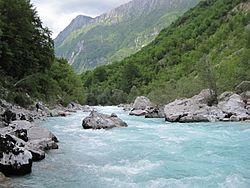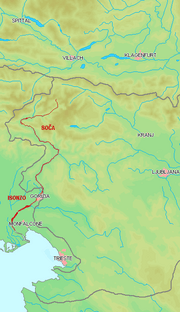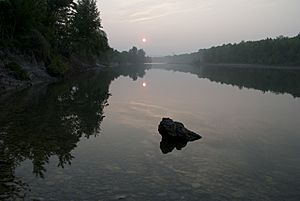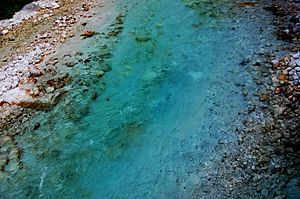Soča facts for kids
Quick facts for kids Soča/Isonzo |
|
|---|---|

The Soča near Bovec
|
|
| Country | Slovenia, Italy |
| Physical characteristics | |
| Main source | Julian Alps, west of Triglav 876 m (2,874 ft) |
| River mouth | Adriatic Sea, near Monfalcone |
| Length | 138 km (86 mi) |
| Basin features | |
| Basin size | 3,400 km2 ([convert: unit mismatch]) |
The Soča river, also known as the Isonzo, is a beautiful river that flows for about 138 kilometers (86 miles) through two countries: Slovenia and Italy. It's famous for its stunning emerald-green water, which is why people often call it "The Emerald Beauty."
This amazing river starts high up in the Julian Alps mountains in northwestern Slovenia. It begins at an elevation of 876 meters (2,874 feet). From there, it travels past several towns like Bovec, Kobarid, and Nova Gorica. Finally, the Soča river flows into the Adriatic Sea near the town of Monfalcone in Italy.
Before World War I, the river was very close to the border between the Kingdom of Italy and the Austro-Hungarian Empire. During the war, this area became a major battlefield. Many important battles took place along the river, especially the Battle of Caporetto in 1917.
Contents
What's in a Name?
The Soča river has had a few different names over a very long time! In ancient Roman times, people called it Aesontius, Sontius, or Isontius. Later, it became known as Sontium and Lisonçum.
The name Soča comes from an older word, *Sǫťa, which was borrowed from the Latin name Sontius. This name might mean "swift" or "rushing," which makes sense for a river that flows quickly. Another idea is that the name comes from an even older word meaning "water" or "river."
How the River Changed Over Time
The Soča river's path has changed a lot over thousands of years. Long ago, a different river system, the Natisone and Torre, flowed where the Soča is now.
Around the year 585, a big landslide happened. This landslide blocked the upper part of the Natisone river. Because of this, the water found a new path and started flowing into a different river called the Bontius.
Over many centuries, the mouth of this new river, the Soča, slowly moved eastward. It eventually connected with another short river called the Sdobba. This is how the Soča river now flows into the Adriatic Sea. The old river mouth became a separate small stream.
Amazing Things to See and Do
The Soča river is truly special because of its amazing emerald-green water. It's one of the few rivers in the world that keeps this beautiful color along its entire length.
This river has even inspired famous artists! An Italian poet named Giuseppe Ungaretti wrote about the Isonzo in his poem "The Rivers." A famous Slovene poet, Simon Gregorčič, wrote his best-known poem, Soči (To the Soča), about the river.
If you're a movie fan, you might recognize the area around the Soča river. It was used as a filming location for the 2008 Disney movie Chronicles of Narnia: Prince Caspian!
The river is also home to a special fish called the marble trout (Salmo marmoratus). This type of trout naturally lives in rivers that flow into the northern Adriatic Sea. It's an endangered species, partly because other types of trout were introduced to the river between World War I and World War II.
The Soča River in World War I
The valley of the Soča river was a very important place during World War I. From May 1915 to November 1917, many major battles took place here. These were known as the Twelve Battles of the Isonzo.
Over half a million soldiers from the Austro-Hungarian Empire and Italy lost their lives in these battles. It was a very difficult and intense part of the war.
Here are the names of the main battles that happened along the Isonzo river:
- First Battle of the Isonzo: June 23 – July 7, 1915
- Second Battle of the Isonzo: July 18 – August 3, 1915
- Third Battle of the Isonzo: October 18 – November 3, 1915
- Fourth Battle of the Isonzo: November 10 – December 2, 1915
- Fifth Battle of the Isonzo: March 9–17, 1916
- Sixth Battle of the Isonzo: August 6–17, 1916
- Seventh Battle of the Isonzo: September 14–17, 1916
- Eighth Battle of the Isonzo: October 10–12, 1916
- Ninth Battle of the Isonzo: November 1–4, 1916
- Tenth Battle of the Isonzo: May 12 – June 8, 1917
- Eleventh Battle of the Isonzo: August 19 – September 12, 1917
- Twelfth Battle of the Isonzo: October 24 – November 7, 1917 (also known as the Battle of Caporetto)
See also
 In Spanish: Isonzo para niños
In Spanish: Isonzo para niños
- Karst topography
- Battles of the Isonzo
- Gorizia
- Goriška





